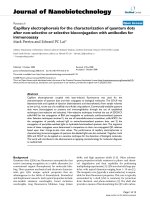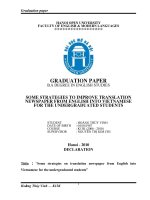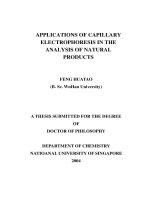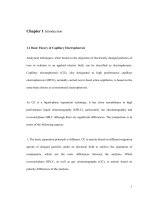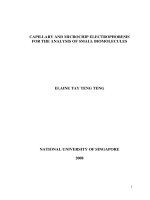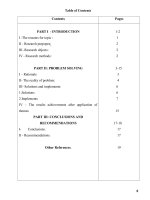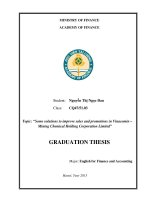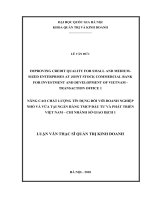Development of methods to improve sensitivity and portability of capillary electrophoresis for the analysis of stabilizers and drugs 1
Bạn đang xem bản rút gọn của tài liệu. Xem và tải ngay bản đầy đủ của tài liệu tại đây (117.34 KB, 16 trang )
Acknowledgements
First of all, I would like to express my sincere thanks to my supervisor, Professor
Sam F. Y. Li, for his invaluable suggestions, guidance and encouragement during the
course of my work.
Special thanks go to all the kind staff in Chemistry Department in particular Ms
Tang C. N., Dr. Wang T. L., Mdm Lim F. and Mdm Wong L. K
Many thanks are due to all of my lab mates, Dr. Wei H. P., Dr. Ng H. T., Dr. Fang A.
P., Dr. Qin W. D., Dr. Feng H. T., Mr. Yu L. J., Mr. Law W. S., Mr. Roderick Borong
Pernites, Miss Xu Y., Miss Lau H. F., Miss Junie Tok, Mr. Jiang Z. J. for their help
and encouragement.
I sincerely appreciate the National University of Singapore for providing me the
financial support during my research.
Last but not least, thanks very much to my parents for their endless understanding,
concern and support.
i.
TABLE OF CONTENTS
Acknowledgements…………………………………………………………….… ….… i
Table of Contents……………………………………………………………………. ii~vii
Abbreviations……………………………………………………………………….viii~xi
Publications……………………………………………………………………… xii~xiii
Summary………………………………………………………………… ……….xiv~xvi
Chapter 1 Introduction……………………………………… ……. 1~57
1.1 Basic Theory of Capillary Electrophoresis………………………….… 1~6
1.2 Electroosmotic Flow (EOF)…………………………………………… 6~13
1.3 Different Modes of CE…………………………………………….…… 13~20
1.3.1 Capillary Zone Electrophoresis (CZE)……………………… 13~14
1.3.2 Micellar Electrokinetic Chromatography (MEKC)………….…. 14~15
1.3.3 Capillary Gel Electrophoresis (CGE)…………………………. . 15~16
1.3.4 Capillary Isoelectric Focusing (CIEF)……………………….…. 16~17
1.3.5 Capillary Electrochromatography (CGE)………………………. 17~18
1.3.6 Capillary Isotachophoresis (CITP)……………………… …… 18~20
1.4 Sample Introduction and Concentration………………………………… 20~31
1.4.1 Sample Introduction………………………………………………20~22
1.4.2 On-line Concentration Technique in CE………………………… 22~32
1.4.2.1 Sample Stacking……………………………………… 23~26
ii.
1.4.2.2 Field Amplified Sample Injection (FASI)……………. 26~28
1.4.2.3 Isotachophoresis (ITP)……………………… ……… 28~29
1.4.2.4 pH-related Stacking……………………………… …… 29~31
1.4.2.5 Sweeping………………………………………….………. 31
1.5 Different Detection Methods with CE…………………………………… 31~38
1.5.1 UV Detection………………………………………………………. 33
1.5.2 Fluorescence Detection…………………………………… ……. 33~34
1.5.3 Electrochemical Detection………………………………… … 34~38
1.5.4 Other Detection ………….…………………………………………… 38
1.6 Current Trends of CE……………………………………………… …… 38~45
1.6.1 Brief History of CE…………………………………… ………. 38~40
1.6.2 General Introduction of Several Trends in CE Field………………… 40
1.6.3 CE-MS………………………………………………………… 40~42
1.6.4 Miniaturization of CE…………………………………………… 42~44
1.6.5 Methods Development of Improving Sensitivity in CE…… … 44~45
1.7 Scope of Research ………….……………………………………….…… 45~50
References……………………………………………………………… …… 51~57
Part I Sensitivity Improvement for MEKC of Stabilizers with UV
Detection …………………………………………………………… 58~94
Chapter 2 Modified Field Amplification Sample Injection for MEKC of
iii.
Neutral Compounds……………………………………… …… 59~79
2.1 Introduction………………………………………………………… … 59~60
2.2 Materials and Methods…………………………………………………. 60~63
2.3 Results and Discussion…………………………………………………. 63~76
2.3.1 Basic Consideration……………………………………………… 63~66
2.3.2 Modified Field Amplification Sample Injection………………… 66~67
2.3.3 Effect of Stability of Inclusion Complexes on Concentration
Factor……………………………………………………………………… 67~69
2.3.4 Effect of Displacer plug on Concentration Factor…………………69~73
2.3.5 Optimization of Injection Time……………………………………73~75
2.3.6 Evaluation of Analytical Performance of Modified Field Amplification
Sample Injection…………………………………………………………… 75~76
2.4 Conclusions………………………………………………………………76~77
References……………………………………………………………………78~79
Chapter 3 Application of Fast Analysis of Stabilizers in Gunpowder on
Portable CE with UV Detection …………………………….………80~94
3.1 Introduction ………………………………………………………….… 80~83
3.2 Materials and Methods……………………………………………….… 83~85
3.3 Results and Discussion………………………………………….……… 85~92
3.3.1 Basic Consideration……………………………………….……….85~86
iv.
3.3.2 Optimization of Buffer Concentration…………………….….…….86~87
3.3.3 Optimization of Sample Solvent ………………… ……… …… 87~88
3.3.4 Linearity, Repeatability and Limits of Detection………….….…….88~89
3.3.5 Application and Comparison with the HPLC Results………………89~92
3.4 Conclusions……………………………………………………….………92~93
References…………………………………………………………………… 93~94
Part II Direct Determination of non-UV Active Drugs with
Electrochemical Detection on Portable CE System………… …….95~156
Chapter 4 Direct Determination of Antibiotics Components on portable
CE System …………………………………………………… …… 96~124
4.1 Introduction…………………………………………………….…………96~100
4.2 Materials and Methods…………………………………………………. 100~105
4.3 Results and Discussion of Gentamicin Experiments…………….………105~113
4.3.1 Basic Consideration………………………………………….…… 105~107
4.3.2 Buffer System and pH Optimization…………………… ………. 107~108
4.3.3 Effect of CTAB Concentration…………………………………… 108~109
4.3.4 Buffer Concentration Optimization…………………………… 109~113
4.4 Results and Discussion of Neomycin Experiments……………… …… 113~120
4.4.1 Basic Consideration…………………………………….………….113~114
4.4.2 Separation Medium Optimization…………………………….…………114
v.
4.4.3 Separation Voltage Optimization………………………… …….114~115
4.4.4 Linearity, Repeatability and Limits of Detection………… ……115~119
4.4.5 Application………………………………………………….……119~120
4.5 Conclusion………………………………………………………….….120~121
References ………………………………………………………… …….122~124
Chapter 5 Chiral Separation of Gentamicin Components on Portable CE
System …………………………………………………………… 125~140
5.1 Introduction……………………………………………………………125~126
5.2 Materials and Methods……………………………………………… 126~129
5.3 Results and Discussion…………………………………………….… 129~137
5.3.1 Chiral Separation……………………………………….……… 129~130
5.3.2 Buffer System and pH Optimization…………………………….130~131
5.3.3 Effect of Vancomycin Concentration……………………………131~132
5.3.4 Linearity, Repeatability and Limits of Detection……………… 132~136
5.3.5 Real Sample Analysis…………………………………….…… 136~137
5.4 Conclusion…………………………………………………….……… 137~139
References ……………………………………………………………… 139~140
Chapter 6 Fast Analysis of Carnitine on Portable CE
System …………………………….………………………………141~155
6.1 Introduction ………………………………………………………… 141~144
vi.
6.2 Materials and Methods……………………………………………… 144~146
6.3 Results and Discussion……………………………………………… 146~153
6.3.1 Basic Consideration…………………………………………….146~147
6.3.2 Buffer Optimization …………………………………………….147~152
6.3.2.1 Buffer System………………………………………… 147~148
6.3.2.2 Effect of pH Value………………………………… 148~149
6.3.2.3 Linearity, Repeatability and Limits of Detection……….149~151
6.3.5 Determination of Real Sample …………………….……………151~153
6.4 Conclusions…………………………………………………………………153
Reference………………………………………………………………… 154~155
Chapter 7 Concluding and Future Work ……………………… 156~160
vii.
Abbreviations
2nDPA 2-Nitro Diphenylamine
4nDPA 4-Nitro Diphenylamine
β-CD-NH
2
mono(6-amino-6-deoxy)-β-cyclodextrin
AC 1-Adamantanecarboxylic acid
ACN Acetonitrile
ADAM 9-anthryldiazomethane
BGE Background electrolyte
C4D Capacitively coupled contactless conductivity detection
CCD Contactless conductivity detector
CD Cyclodextrin
CE Capillary Electrophoresis
CEC Capillary Electrochromatography
CF Concentration factor
CF-FAB Continuous-flow fast atom bombardment
CGE Capillary gel electrophoresis
CIEF Capillary isoelectric focusing
CIS Coordination ion spray
CITP Capillary isotachophoresis
CTAB Cetyltrimethylammonium bromide
viii
CZE Capillary zone electrophoresis
DC Direct current
DPA Diphenylamine
EC Ethyl centralite
ECD Electrochemical detection
EOF Electroosmotic flow
EP European Pharmacopoeia
ESI Electrospray ionization
FAB–MS Fast atom bombardment mass spectrometry
FASI Field amplified sample injection
FMOC 9-fluorenylmethyl chloroformate
GC Gas chromatography
GC-MS Gas chromatography–mass spectrometry
HPCE High performance capillary electrophoresis
HPLC High performance liquid chromatography
ID Internal diameter
IS Internal standard
ITP Isotachophoresis
LC Liquid chromatography
LIF Laser-induced fluorescence
ix.
LOD Limit of Detection
LVSS Large volume sample stacking
MAA Mercaptoacetic acid
MALDI-MS Matrix-assisted laser desorption/ionization mass spectrometry
MC Methyl centralite
MEKC Micellar Electrokinetic Chromatography
mFASI Modified field amplified sample injection
MS Mass spectrometry
NaOH Sodium Hydroxide
NE1 1-naphthaleneethanol
NM1 1-naphthalenemethanol
NM2 2-naphthalenemethanol
NMR Nuclear magnetic resonance
N-nDPA N-Nitroso Diphenylamine
NSM Normal stacking mode
OD Outside diameter
OPA 1,2-phthalic dicarboxaldehyde
PAD Pulsed amperometric detection
PGD Potential gradient detection
PVA Polyvinylalcohol
x.
PVP Polyvinylpyrrolidone
RSD Relative standard deviation
SFC Supercritical fluid chromatography
SDS Sodium dodecyl sulfate
TLC Thin layer chromatography
USP US Pharmacopoeia
UV-Vis Ultraviolet-visible
xi
Publications
1. TianLin Wang; LingLing Yuan; Sam Fong Yau Li, Modified Field Amplification
Sample Injection for Micellar Electrokinetic Chromatography of Neutral Compounds
with Amino-Substituted Cyclodextrin as Carrier and 1-Adamantanecarboxylate as
Displacer, J. Chromatogr. A, 1013, 2003, 19-27
2. HuaTao Feng; LingLing Yuan; Sam Fong Yau Li, Analysis of Chinese medicine
preparations by capillary electrophoresis–mass spectrometry, J. Chromatogr. A,
1014, 2003, 83-91
3. Lijun Yu, LingLing Yuan, Huatao Feng, Sam Fong Yau Li, Determination of the
bacterial pathogen (Edwardsiella tarda) in fish species by capillary electrophoresis
with blue light-emitting diode induced fluorescence, Electrophoresis, 25, 2004,
3139-3144
4. LingLing Yuan, HongPing Wei, Sam Fong Yau Li, Direct Determination of Gentamicin
Components by Capillary Electrophoresis with Potential Gradient Detection,
Electrophoresis, 26, 2005, 196-201
5. Wai Siang Law, Pavel Kubáň, LingLing Yuan, Jian Hong Zhao, Sam Fong Yau Li, Peter
C. Hauser, Determination of Tobramycin in Human Serum by Capillary
Electrophoresis with Contactless Conductivity Detection, Electrophoresis, in press
6. LingLing Yuan, HongPing Wei, HuaTao Feng, Sam Fong Yau Li, Fast Analysis of
Native Neomycin Components by Capillary Electrophoresis with Potential Gradient
xii.
Detection, Analytical and Bioanalytical Chemistry, accepted
7. LingLing Yuan, Cerenna Ng, Sam Fong Yau Li, Simultaneous Separation of Chiral and
Other Components of Gentamicin on a Portable Capillary Electrophoresis System with
Potential Gradient Detectio, J. Chromatogr. A, submitted
8. LingLing Yuan, Sam Fong Yau Li, Fast Analysis of Carnitine on Portable Capillary
Electrophoresis System with Contactless Conductivity Detection, J. Chromatogr. A,
submitted
xiii.
Summary
This work mainly focused on the development of methods to improve sensitivity and
portability in capillary electrophoresis systems. With the high separation efficiency, high
resolution and portability, CE has been proven a powerful method for the studies of many
groups of compounds. The improvement of sensitivity and the miniaturization of CE
technique are two major trends of capillary electrophoresis which have gain more and
more attention. In this work, approaches to enhance sensitivity and portability of CE are
investigated.
A modified field amplification sample injection method was proposed and evaluated by
using positively mono-charged cyclodextrin (CD) as carrier and 1-adamantanecarboxylate
as displacer for on-capillary preconcentration of neutral stabilizers in pharmaceutical
products and improvement of the concentration limit of detection (LOD) in micellar
electrokinetic chromatography (MEKC). In this mode a displacer plug was introduced
before sample injection to reduce the length of the concentrated sample zone and increase
the peak height by slowing down the forward movement of the neutral sample associated
with β-CD-NH
2
and the backward movement of the neutral sample partitioned in the
micelles of sodium dodecyl sulfate (SDS). Stability of the inclusion complexes formed
between the carrier and the solute was found to be an important factor affecting stacking
efficiency in both the conventional field amplification sample injection mode and the
xiv
modified one. However, further enhancement of the stacking efficiency in the modified
mode rested on the relative stability of the displacer-carrier complex to that of the
solute-carrier complex.
Next, a new method to test stabilizers in gunpowder was optimized, validated and applied
on the stabilizers analysis in real gunpowder samples. Good sensitivity, linearity and
reproducibility were obtained after optimization. The results obtained by CE were
compared with those of high performance liquid chromatography (HPLC), which showed
the capillary electrophoresis (CE) method on our portable CE instrument can be a good
alternate method for HPLC, with the advantage that it can be more readily applied in
on-site analysis.
A simple and fast method was developed to determine non-UV active compounds directly
without derivatization on a portable capillary electrophoresis system with potential
gradient detection. The usefulness of the method was demonstrated by detecting the major
components in aminoglycoside antibiotic mixtures. Gentamicin was separated into several
peaks in 15 minutes, and neomycin into three peaks even faster within 4 minutes. This
method showed better sensitivity (LOD 7~10 ppm) than other CE methods for
determining
underivatized gentamicin and neomycin with large linear range (10~1000
ppm). Because of its good repeatability (RSD <5 %) and simplicity, this new method
xv.
could be a good alternative for the current assays given by US Pharmacopoeia (USP) and
European Pharmacopoeia (EP).
A further improved method was developed to determine gentamicin’s two stereoisomer
components (C2, C2a) as well as two other major components (C1 and C1a). Chiral
separation was achieved by using 0.2mM CTAB, 1mM vancomycin and 1mM ammonium
citrate buffer system, pH3.5. Large linear range, good repeatability and simplicity of the
method could render itself a good alternate method to HPLC also. The experiments were
developed on the same portable capillary electrophoresis system as in the previous chapter,
and potentially can be used for field analysis of chiral compounds.
In addition, a fast method for the analysis of underivertized carnitine was developed on a
portable capillary electrophoresis system with capacitively coupled contactless
conductivity detection (C4D). Compared with potential gradient detection, the C4D
method has the advantage that there is no need to custom-make a detection cell for each
capillary. The LOD was found to be 3ppm. The linear range was between 3 to 1000 ppm,
and RSD value was satisfactory, i.e. < 1.5% in the same day and < 5% on different days.
The simplicity, low LOD, wide linearity and good repeatability of the method render itself
a good alternate method to the HPLC method recommended by USP.
xvi.
